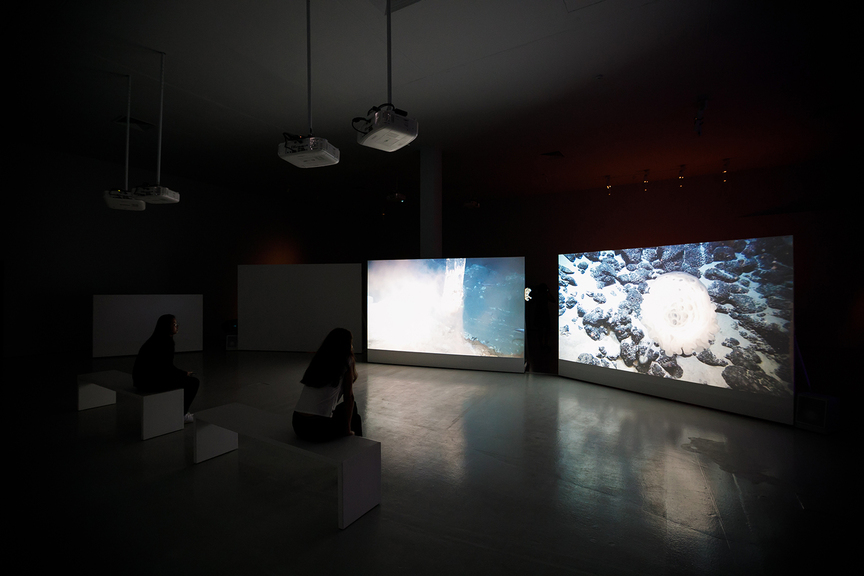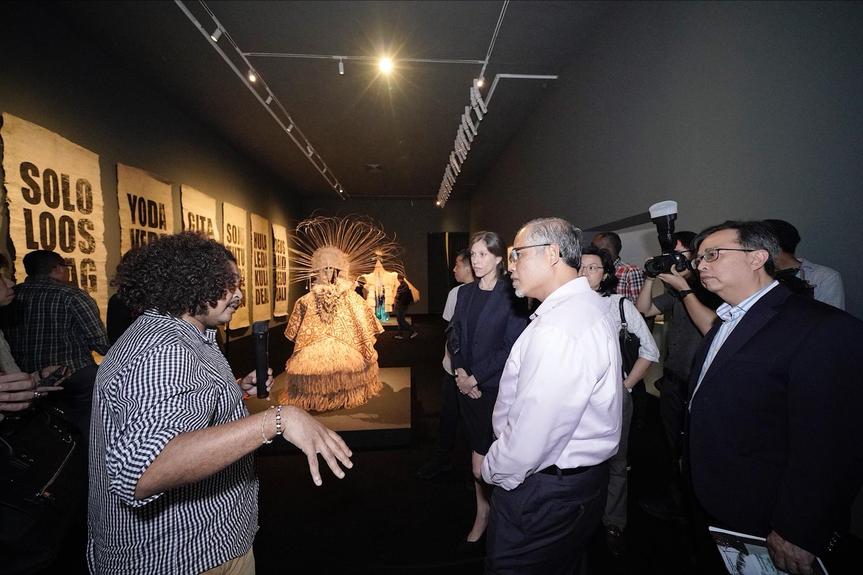
R
E
V N
E
X
T
The vitality of our oceans is crucial to human survival. Yet, for most city dwellers, we have the luxury of hiding within our comfortable communities and neglecting the damage done to our waters. NTU Centre for Contemporary Art Singapore (NTU CCA) shed light on the environmental and social concerns pertaining to the Pacific Ocean in its latest exhibition, “The Oceanic.” The presentation involved contributions from 12 artists, researchers, filmmakers and composers who traveled to Pacific archipelagos. These contributors are fellows at The Current, an ongoing research initiative developed by the interdisciplinary arts organization Thyssen-Bornemisza Art Contemporary–Academy (TBA21–Academy). In the past three years, the Academy hosted three expeditions—to Papua New Guinea in 2015, French Polynesia in 2016, and Fiji in 2017—in order to better understand the ecological, social and economic issues faced by those who live in the Pacific region. Ute Meta Bauer, curator and founding director of NTU CCA, served as the expedition leader for these trips. Conceived as a reflexive exhibition, “The Oceanic” gave viewers insight into the experiences and knowledge that the 12 fellows cultivated during their journeys.
ArtAsiaPacific sat down with Bauer and TBA21–Academy co-founder Markus Reymann to discuss the role of visual arts in the discourse on climate change, the challenge of using the exhibition space to stimulate environmental awareness, and taking art initiatives related to oceanic issues beyond gallery presentations.
You both partook in the expeditions to Papua New Guinea, French Polynesia and Fiji. How do the issues that you explored in these communities link up with our lives in Singapore—or elsewhere in the world?
Bauer: When living in cities, we often don’t see the effects of climate change because we compensate. If it rains, we take an umbrella; when it’s cold, we turn the heat up. The expeditions allowed us to visit just three areas, but the experiences showed us how societies are intertwined. The islands we visited contribute just one to two percent of [global] carbon dioxide emissions. Technically, these communities should not feel the effects of climate change because they are not generating anything, but, in reality, they are the people who are most impacted by the damage caused by the rest of us. We are not separate from them, the ocean connects us. This is something that is sensitive in the Pacific, because communities there have undergone centuries of exploitation. The colonizers are gone, but we exploit them in other ways: their seabeds get mined, and toxins are dumped into the ocean. There’s a lot of anger there and it is a complex problem, but we have to start somewhere.
Most of the artworks presented in “The Oceanic” are conceptual and abstract. Furthermore, the contributors explore the Pacific from different angles—cultural, ecological, economic—and use different mediums. All of this can make the show overwhelming for the viewer. How do you think the diversity and complexity of visual material affect the accessibility of the exhibition?
Reymann: The Pacific is a vast, diverse and complex geopolitical space. The overwhelming experience of the exhibition evokes that for the audience. I was concerned that the exhibition space would be too didactic to transport the complexities of the Pacific, but Ute was courageous enough to let the works influence each other. The exhibition is an open floor plan—it does not isolate any of the artworks—which facilitates a different quality when they are seen in the context of each other. The exhibition space becomes more like a stage—an experiential space.
Bauer: We didn’t want to shy away from the complexity, to break it down, to spoonfeed it in portions. We avoided displaying photographs from the expeditions, even though I knew doing so would make the exhibition less abstract. You will see photographs in The Lab [NTU CCA’s platform to show research that is in progress], but we were not ready to expose the images that we generated in the exhibition room. Who are we to show images of these people? Maybe they don’t want to be represented by us. At The Current’s “Convening #3 Tabu / Tapu – Who Owns the Ocean?”, we invited experts from various fields from Papua New Guinea, Fiji and French Polynesia, as well as The Current’s fellows and thought leaders, to discuss who owns the ocean, but also who owns images of the ocean. It is important to bring together policymakers, scientists, artists. We need the complexities of the disciplines to match something as challenging as climate change.
The exhibition and the Convening invited all of us to consider the impact of climate change on the Pacific, but those conversations are still limited to participants who engage within institutionalized cultural spaces. Do you see the artworks from this exhibition entering realms beyond the gallery?
Reymann: That is a challenge: how do we communicate outside of these silos? The art space is a silo. It works as a format, but we need to find different places for these works and a different audience. As an organization, TBA21–Academy applied for United Nations observer status at the Assembly of the International Seabed Authority, a body tasked with the administration and distribution of resources in international waters. TBA21–Academy was the first arts organization to be granted this status. This means we can be at the meetings and that we can apply for speaking time at the General Assembly, which will allow us to bring a different language to this platform: the language of art. As cultural producers, we should not be satisfied with the spaces that we are given. We should take space if we think it is necessary to be occupied. The wearable sculptures by Laura Anderson Barbata in “The Oceanic” were created for Ocean Calling (2017), a performance done on World Ocean Day 2017 in the plaza in front of the UN headquarters [in New York]. It was a logistical nightmare bringing multiple performers—which included the Brooklyn Jumbies and Sinuhé Padilla Jarana Beat musicians—to the plaza, but it was important that there was a different language introduced on that day.
LISA RAVE, Fisherwoman, 2017, photo documentation research of Fiji’s Lau Islands, dimensions variable, for “TBA21–Academy The Current Convening #3 Tabu/Tapu,” NTU Centre for Contemporary Art Singapore, 2018. Courtesy NTU Centre for Contemporary Art Singapore.
Barbata’s Ocean Calling is inspired by her experiences in Papua New Guinea but also draws from African-Caribbean cultures by bringing in the Brooklyn Jumbies to perform in her work. It is a layered performance piece with a variety of cultural influences. What were some of the reactions to the work on World Ocean Day?
Reymann: It was well-received; I was very surprised. There was uncertainty within our expedition group before the performance took place. Ute was unsure if we should do it.
Bauer: I was afraid the performance would be seen as a spectacle. I didn’t want it to look exotic or seem as though Barbata was appropriating other cultures in her work, because she is very fair in her exchanges. I think there is a lot of potential in the performativity, but it has to be done thoughtfully so that it’s not seen as too literal. Sometimes, when we see people in traditional costumes, we think this cannot be real anymore. But when the villagers in Papua New Guinea did their welcome dance for us, it was real. It is what they would have done for any other villages that visited them—it’s their tradition. Barbata’s Ocean Calling was partially inspired by that experience, but the issue of representation is why I didn’t want to have photographs in the exhibition to begin with.
“The Oceanic” marks the beginning of NTU CCA’s new overarching research topic “Climates. Habitats. Environments.” Where do you see the institution taking this topic?
Bauer: Issues around climate change and the Pacific are very loaded. We have to give these topics the time they need. I don’t have the answer to your question, I think we are just at the beginning. I want to come back to these issues like a thread but without being dogmatic. Because even if we want to go into a new project next week, maybe we can’t. So let’s give it time—we can take one step now and come to another step next year. We don’t have answers, but we are hoping to be more precise with our questions. How can we be more connected? Can artists contribute to what scientists and activists do? The big issues in our world cannot be solved by one discipline, we have to talk to each other.
“The Oceanic” is on view at NTU Centre for Contemporary Art, Singapore, until March 4, 2018.
To read more of ArtAsiaPacific’s articles, visit our Digital Library.






